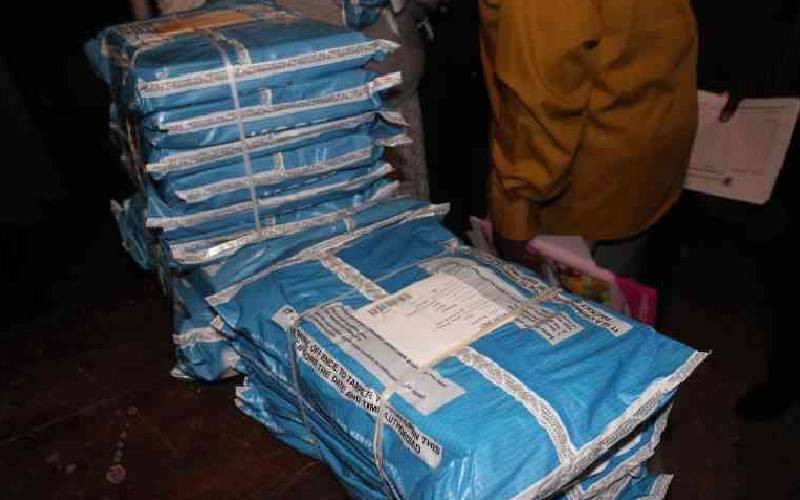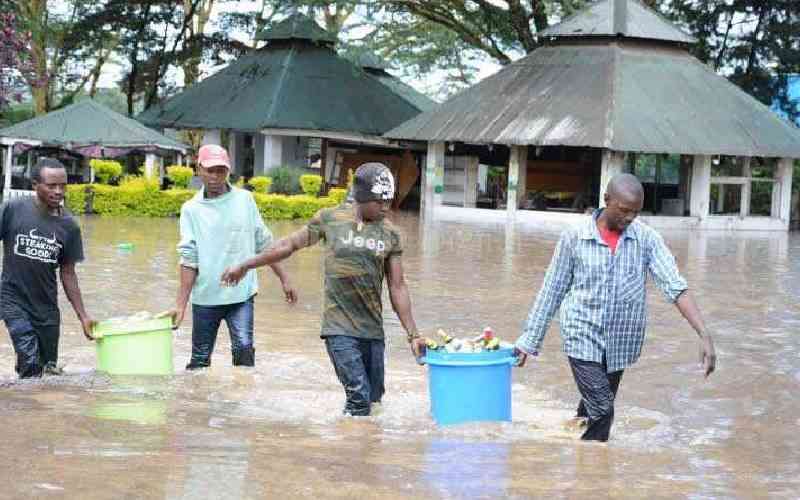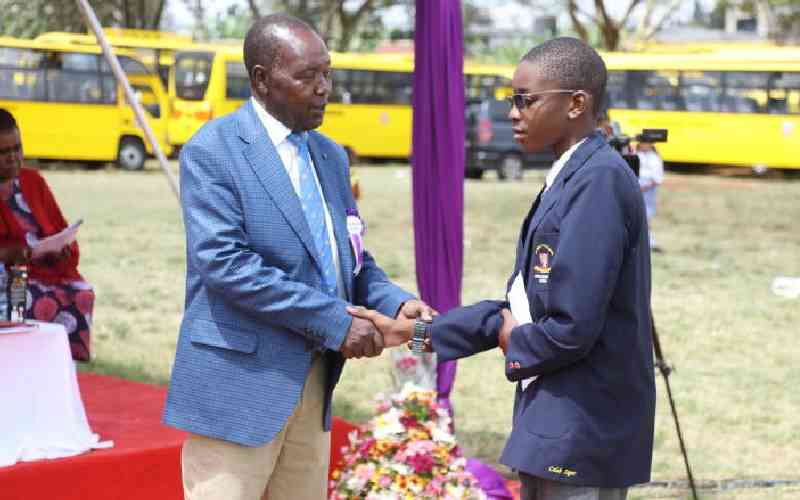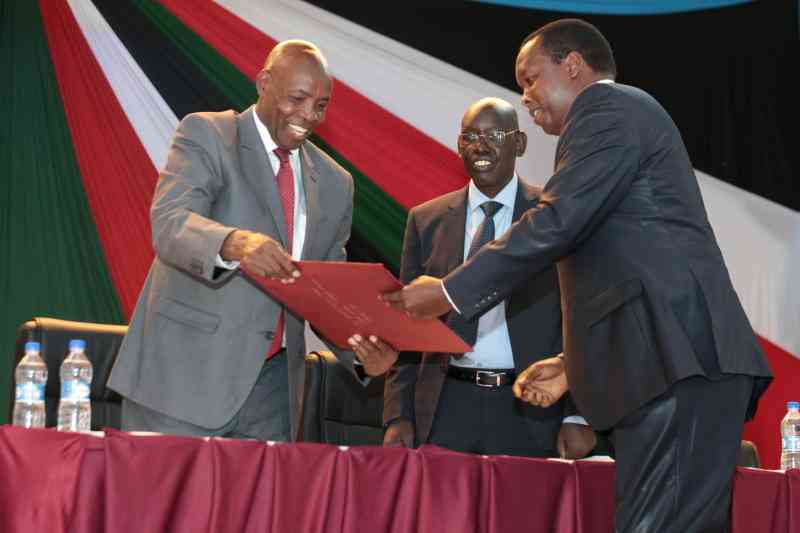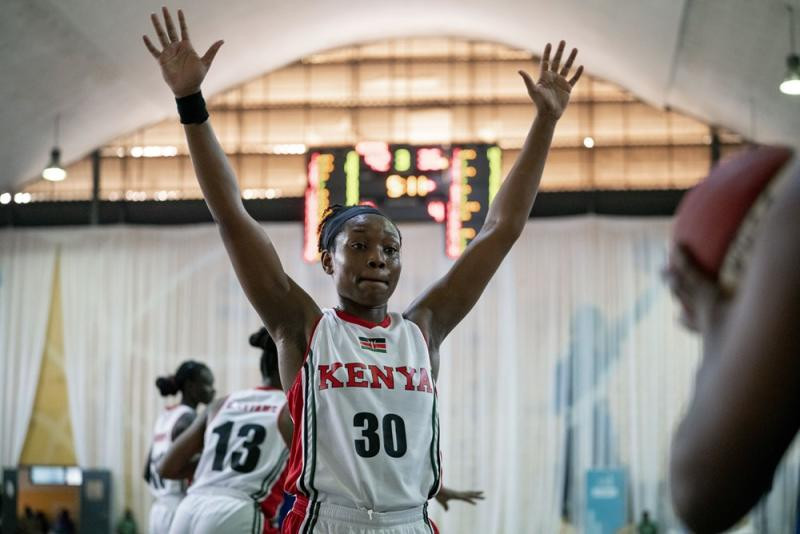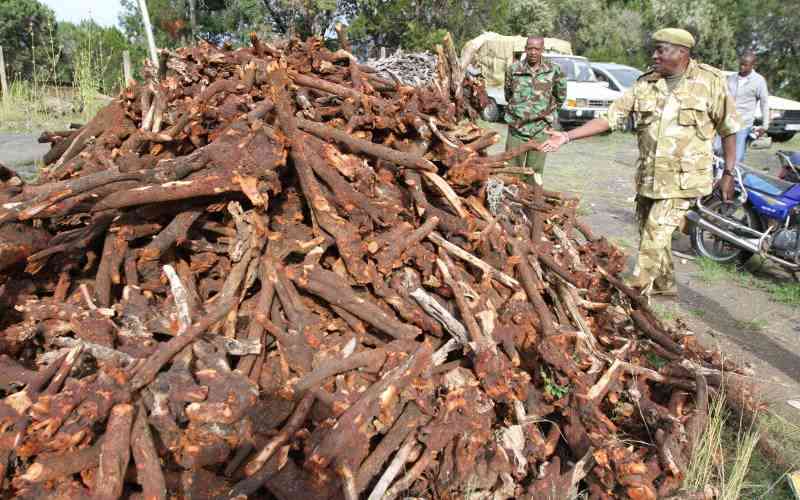Good morning.
- PREAMBLE
It gives me great pleasure to welcome you all to the release of the year 2015 KCPE examination results. This being my first time to release these examination’s results, please join me in formally acknowledging that the 2015 KCPE examination cohort has achieved this great milestone of completing a full cycle of primary education.
- ACHIEVEMENTS MADE IN THE EDUCATION SECTOR
- Increase in Access, Equity and Quality of Education
Ladies and gentlemen, education and training is key in the realization of socio- economic development. The Government is committed to actualising the Constitution of Kenya 2010 as per:-
- Article 43 (1)(f) ; Every person has the right to education;
- Article 53 (1) (b): Every child has the right to free and compulsory basic education.
In this regard the Government has continued to increase access, equity and quality of education in accordance with Education For All (EFA), Millennium Development Goals (MDGs), Vision 2030, the Constitution 2010 and the sustainable development goals (SDGs)
The Basic Education Act 2013 provides for the promotion and regulation of free and compulsory basic education. This includes penalties on the part of both teachers and parents who deny school going children the right to education through repeating of classes or child labour among others.
- CAPITATION GRANTS FOR PRIMARY, SECONDARY AND YOUTH POLYTECHNIC INSTITUTIONS
Ladies and gentlemen, the Government has been providing Capitation grants of Kshs. 1,020 per pupil under the Free Primary Programme and Capitation grants of Kshs. 10,265 per student for all secondary schools students since 2003 and 2008 respectively. The capitation has been increased to Kshs. 1,420 for primary school pupils and 12,687 for secondary school students in 2014. This represents an increase of 39% and 23% respectively for the year 2014/2015. In the Financial Year 2015/2016, the Ministry used Kshs. 10billion to support 9.1 million pupils in public primary schools and Kshs. 21billion to cater for 2.2million students in public day secondary schools. In addition, the Ministry has allocated 826 million to support 55,000 trainees as capitation grant at Kshs. 15,000 per trainee in youth polytechnics.
- EXAMINATION FEES FOR CANDIDATES IN PUBLIC SCHOOLS
The Government is also paying examination fees for all candidates in Public Primary and Secondary Schools. In the Financial Year 2014/2015 – Kshs. 2.9 billion was paid to Kenya National Examinations Council as Examination fees, while during the current F/Y 2015/2016 the Ministry has earmarked Ksh 3 billion for Examination fees.
- FUNDING OF OTHER PROGRAMMES IN THE EDUCATION SECTOR
Ladies and gentlemen, the interventions are not limited to FPE and FDSE , but cover a wide range of programmes such as Special needs Education (SNE), Alternative Provision of Basic Education and Training (APBET), Schools infrastructure, School feeding Programme (SFP) and the marginalized in Arid and Semi- Arid Lands (ASALs). The marginalized in urban Informal Settlements have received targeted intervention through the development of APBET Policy and the finalization of APBET registration guidelines. APBET institutions have also benefited from FPE support grants. In the FY 2015/2016, a total of Ksh. 93, 049,011 has been disbursed to 431 APBET institutions with an enrolment of 131,311 learners to cater for instructional materials needs.
- SANITARY TOWELS PROGRAMME
Ladies and gentlemen, to promote access, equity and quality in Education, the Ministry has been implementing the Sanitary towels programme since the financial year 2011/2012. In the FY 2015/ 2016, a total of Kshs. 400 Million has been set aside for purchase of sanitary towels for 14, 316 School girls country –wide.
- ADULT AND CONTINUING EDUCATION
In the last few years, there has been great demand for Adults to undertake the KCPE examination. This has been the case as a result of learners dropping out of the formal system, for various reasons.
In 2015, the Directorate of Adult and Continuing Education had a total of 2,834 candidates who were registered to take the KCPE examinations. This was an improvement compared to 2,142 candidates who sat the KCPE examination in 2014, an increase in enrolment by 592 candidates, amounting to 27.64% increase.
- PARTICIPATION OF LEARNERS IN CO-CURRICULAR ACTIVITIES
It is regrettable to note that a number of our institution have given undue emphasis to cognitive and a bit on the affective domains while ignoring the psychomotor skills which are best delivered through Physical education, play and co-curricular activities.
It is also worth noting that learners who participate in co-curricular activities perform better in academics and have more opportunities in getting employed and also earning from their talents. I wish to reiterate the policy of the ministry on participation of all learners in co-curricular activities and teaching of Physical Education not only as a way of identifying and developing the learners’ talent but also for promoting good health among the children.
- EDUCATION REFORM
Currently, the Ministry of Education, Science and Technology, through the Kenya Institute of Curriculum Development (KICD) has embarked on education reform, which seeks to shift the curriculum from the subject-based to a competence-based curriculum. The vision of the curriculum reform is; ‘Nurturing Every Learner’s Potential’. The reform will address key issues such as ethical values, equity, diversity, equality of opportunity and excellence for all learners. In this regard, from January 2016 KICD will be conducting a needs assessment to ascertain the actual market needs and identify the inherent gaps in the current curriculum. I wish to therefore call on all the stakeholders (policy makers, industries, learners, parents, educationists and other professionals) to give their submissions and information to KICD so that the process is participatory and inclusive as envisaged by the Constitution.
- CHALLENGES FACED BY EDUCATION SECTOR
Before I go into matters pertaining to the release of the 2015 KCPE examination, I wish to recognize that the education sector in this country has faced a number of challenges in the recent past and my Ministry and other education stakeholders will work hand in hand starting in the New Year to ensure that the aspirations of Kenyans on matters of education are achieved.
Stay informed. Subscribe to our newsletter
Turning to the Kenya National Examinations Council, I wish to note that we are looking into the challenges faced by the Kenya National Examinations Council during the administration of the 2015 national examinations in a bid to come up with solutions that will ensure that such challenges are avoided in the future.
An in-depth audit is currently being conducted to determine the root cause(s) of the challenges experienced during the administration of the 2015 KCPE and KCSE examinations. This involves auditing all examination processes undertaken this year from setting of questions to the actual administration of the examinations to be able to understand the underlying causes of the challenges that were encountered so as to come up with the most effective strategies to avert a repeat of the same in the future.
- THE 2015 KCPE EXAMINATION RESULTS
- The 2015 KCPE Examination Candidature
Candidature in the KCPE examination has continued to grow steadily over the years. In the last ten years candidature for the KCPE examination has increased by 261,338 candidates, representing a percentage increase of 39.2%.
In particular, candidature in the KCPE examination increased from 880,486 candidates in the year 2014 to 927,789 candidates in the year 2015, representing a percentage increase of 5.37%. This increase was notably amongst the highest increases in candidature that has been recorded since the inception of the examination. Of the 927,789 candidates who sat for the 2015 KCPE examination, 459,885 were girls, while 467,904 were boys, representing a gender parity of 49.6% girls: 50.4% boys.
- Gender Disparities
The number of girls who sat for the examination increased from 437,228 in the year 2014 to in 459,885 in the year 2015, an increase of 22,657 girls, representing 5.18%, while the boys increased from 443,258 in the year 2014 to 467,904 in 2015, an increase of 24,646 boys, representing 5.56%. While during similar past functions in the last five years we have applauded the consistent percentage increase in the number of girls which has been higher than that of boys, this year we have witnessed a shift in this trend as the percentage increase in the number of boys which stands at 5.56% is higher than that of girls at 5.18%.
Analysis of candidature trends by gender at the County level indicates that in the year 2015 KCPE examination, 23 out of the total 47 counties, had more girls than boys who sat for the KCPE examination. These counties were: Nairobi, Nakuru, Bungoma, Kakamega, Kiambu, Kitui, Machakos, Meru, Kisii, Kericho, Uasin Gishu, Siaya, Trans Nzoia, Nandi, Nyandarua, Nyeri, Vihiga, Nyamira, Embu, Elgeyo Marakwet, Kirinyaga, Makueni and Tharaka Nithi. All these counties also had more female than male candidates who sat for the year 2014 KCPE examination, with the exception of Nyeri county which had fewer female than male candidates in the year 2014 and Taita Taveta county which had more female than male candidates in 2014, but not in 2015.
Further analysis of candidature trends by county shows that there are still some counties where the gender disparity in favour of boys is very high. During the year 2015 KCPE examination, five counties recorded notable gender disparities in favour of boys. These were Mandera (67% boys: 33% girls), Garissa (66% boys: 34% girls), Turkana (65% boys: 35% girls), Wajir (64% boys: 36% girls) and Samburu (61% boys: 39% girls) counties. While in three of these counties the gender disparities continue to narrow as evidenced by the year 2014 KCPE examination gender parities of 67% boys: 33% girls in Garissa and Wajir, and 68% boys: 32% girl in Mandera. In the other two counties (Turkana and Samburu), the gender disparities are increasing as evidenced by disparities of 62% boys: 38% girls and 59% boys: 41% girls respectively. The County Directors of Education in these counties are hereby tasked with putting in place interventions that will ensure that all girls of school - going age in these counties are enrolled in school.
- Under-age candidates
Ladies and Gentlemen, in regard to age, I am gratified to note that the number of under-age candidates, that is, those who sat for the KCPE examination below the age of 12 years decreased from 18,871 in 2014 to 4,955 in 2015, a percentage decrease of 73.74%.I am happy to note that parents are finally heeding my Ministry’s directive to enrol children in school at the appropriate age. The sensitization undertaken by various education stakeholders to educate parents on the dangers of enrolling children in school at a very early age are also bearing fruit as attested by the decrease in the number of underage candidates that sat for this year’s examination. Despite this achievement, there are still some counties that had a large number of underage candidates who sat for the 2015 KCPE examination. These were Nairobi, Kericho, Murang’a, Bomet and Kitui counties. As a Ministry, we shall continue to urge parents to enroll children in school at the right age as the benefits of the same far outweigh the enrolling them in school at a tender age in the long term.
- Candidates with Special Needs
There continues to be a steady increase in the number of learners with special needs attaining a full cycle of primary education and sitting for the KCPE examination. In the year 2015, a total of 2,118 candidates sat for the KCPE examination compared to 2,097 candidates in the year 2014. This included candidates with visual impairments, physical disabilities and hearing impairments.
- Candidates who sat the examination under other special circumstances
It is also important to recognize that KNEC offered the 2015 KCPE examination to 655 prisoners across the country and 58 candidates who were hospitalized during the examination.
- Performance of Candidates
Nationally, candidates’ performance on the basis of raw marks indicates that English Language, Mathematics and Religious Education recorded a slight improvement in performance in the year 2015 when compared to the year 2014 KCPE examination. Religious Education recorded the highest performance in the year 2015 KCPE examination, with a percentage raw mean score of 70.20%, while English Composition had the lowest percentage mean score of 41.38%. The poor performance of candidates in English Composition is worrying because it means that learners lack the ability to creatively and coherently express themselves in prose. I therefore wish to urge parents and teacher to inculcate a reading culture amongst learners as this is the only sure way for them to improve on their writing skills. Further analysis of candidates’ performance based on their raw marks indicates that female candidates performed marginally better than their male counterparts in English Language, English Composition, Kiswahili Language and Kiswahili Insha during the 2015 KCPE examination, a trend that has been replicated in previous years.
Candidates overall performance in the 2015 KCPE examination based on their standardized scores remained relatively the same when compared to that of 2014. This is evidenced by the fact that in the 2015 KCPE examination, the number of candidates who scored an aggregate of 250 marks and above was 455,950 representing 49.14% of the total candidature compared to 436,814, representing 49.61% of the total candidates who took the examination in 2014. This clearly indicates that despite the increase in candidature in the 2015 KCPE examination, candidates’ performance remained comparable to that of the year 2014.
An analysis of candidates’ aggregate scores for the year 2015 KCPE examination is as follows:
|
RANGE OF MARKS
|
NUMBER OF CANDIDATES
|
% OF TOTAL CANDIDATES
|
|
401 - 500
|
7,560
|
0.81%
|
|
301 - 400
|
201,986
|
21.77%
|
|
201 - 300
|
499,568
|
53.84%
|
|
101 - 200
|
215,614
|
23.24%
|
|
000 - 100
|
3,061
|
0.33%
|
Candidates in Garissa, Wajir and Mandera counties recorded better performance in 2015 as shown by mean scores of 176.86, 183.49 and 173.68 compared to 157.56, 175.34 and 151.97 in the year 2014 respectively. These results are surprising given that the three counties experienced serious shortages of teachers this year.
The mean score performance among private school candidates improved slightly from 229.94 in 2014 to 230.14 in 2015 while that of candidates in public schools went down from a mean score of 187.58 in 2014 to 180.87 in 2015. This decrease in mean score could be attributed to the lack of teaching and learning during the five weeks teachers’ strike that preceded the administration of the 2015 examination. It is my belief that labour disputes can be resolved amicably through dialogue without negatively affecting the learning and teaching process.
- Examination Irregularities
During the year 2015 KCPE examination, the KNEC analysed large quantities of information received from the monitoring team, the examiners and the general public among others and identified 2,709 out of 927,789 candidates, representing 0.29% of the total number of candidates who sat for the examination were involved in examination irregularities. These candidates were found in 111 out of 25,127 examination centres, representing 0.44% of the total number of examination centres. During the year 2014 KCPE examination, 0.19% of the total number of candidates who sat for the examination in 0.38% of the total examination centres was involved in examination irregularities. This goes to show that there was a slight increase in the percentage of candidates who were involved in examination irregularities in the year 2015 KCPE examination when compared to the year 2014.
It is important to note that the highest percentage of examination irregularities in the last ten (10) years was recorded in the year 2011 when 7974 (1.03%) of the total candidates who sat for the examination were involved in examination irregularities.
Collusion continue to be the most common form of examination irregularities accounting for 98.7% of the total number of examination irregularity cases reported in 2015 KCPE examination.
Despite the occurrence of examination irregularities being relatively low in the KCPE examination, I am saddened to note that Head teachers and teachers were mostly responsible for encouraging, abetting and perpetuating examination irregularities during the examination. It is difficult to comprehend how some of the very persons entrusted to shape and mentor the children of this nation are the very ones at the fore front of enabling cheating in examinations. I am therefore directing the Kenya National Examinations Council to hand over all the cases of examination irregularities that involved head teachers and teachers to the Teachers Service Commission to enable the Commission take the necessary disciplinary action against them.
Although the Kenya National Examinations Council shoulders the overall responsibility in ensuring that examinations are secure until they get to the candidate, as citizens of this country, we all have a role to play in ensuring that examination malpractices do not occur and reported identified cases to the authorities.
I wish to commend the 12 counties that did not have any cheating cases during the 2015 KCPE examination. To all stakeholders who played a part to ensure that there was no cheating in Taita Taveta, Mombasa, Kilifi, Tana River, Nyeri, Kiambu, Kirinyaga, Marsabit, Uasin Gishu, Kajiado, Elgeyo Marakwet and Siaya counties, I wish to salute you and urge you to keep up the good work that you are doing. I further wish to note that six of these counties, namely: Taita Taveta, Tana River, Nyeri, Kirinyaga and Siaya were also not involved in examination irregularities in the year 2014. Ladies and Gentlemen, join me in applauding these counties with a hearty hand-clap.
- FORM ONE SELECTION FOR 2016
My Ministry takes a keen interest in the selection of candidates for available form one places to ensure fairness. It is for this reason that the ministry has put in place mechanisms to ensure that form one selection for the 2015 KCPE examination cohort commences within the next two weeks.
The Ministry has revised the 2016 Form one admission guidelines after seeking views of Education Stakeholders. County Education Boards will ensure that no child is denied admission in a public school. No levies should be charged for admission or tests administered to such children seeking admission.
I wish to assure parents and guardians that merit, quota allocations, equity, affirmative action and student choice will be the overriding factors to be considered during the selection exercise.
The actual dates when the selection exercise shall be conducted shall be communicated to you in due course.
- RELEASE OF THE 2015 KCPE EXAMINATION RESULTS
Before releasing the 2015 KCPE examination results, I wish to inform all candidates, parents or guardians that the KCPE examination results will be collected by the Head teachers from the Sub County Education offices and that they should therefore collect their results from their respective examination centres or schools after this function. Individual candidates’ results can also be accessed by sending the candidate’s index number through a short text message (SMS) to 22252 immediately after the release and from the KNEC website, www.knec.ac.ke from the 4th of January 2016.
As was the case last year, Head teachers will be required to download and print the on-line results slips for candidates in their schools and authenticate the same before they are released to parents, guardians or candidates. KNEC shall avail these result slips within a week of today’s release of examination results.
It is now my pleasure to declare the 2015 KCPE examination results released and wish all the candidates’ success in their future endeavours and at the same time wish each and every Kenyan “a Prosperous 2016”
May I call upon the Chief Executive and Chairman, KNEC to hand over the results to me as a gesture that the 2015 examination results are officially released.
DR. FRED O. MATIANG’I, CABINET SECRETARY
MINISTRY OF EDUCATION, SCIENCE & TECHNOLOGY
WEDNESDAY, 30TH DECEMBER 2015
 The Standard Group Plc is a
multi-media organization with investments in media platforms spanning newspaper
print operations, television, radio broadcasting, digital and online services. The
Standard Group is recognized as a leading multi-media house in Kenya with a key
influence in matters of national and international interest.
The Standard Group Plc is a
multi-media organization with investments in media platforms spanning newspaper
print operations, television, radio broadcasting, digital and online services. The
Standard Group is recognized as a leading multi-media house in Kenya with a key
influence in matters of national and international interest.
 The Standard Group Plc is a
multi-media organization with investments in media platforms spanning newspaper
print operations, television, radio broadcasting, digital and online services. The
Standard Group is recognized as a leading multi-media house in Kenya with a key
influence in matters of national and international interest.
The Standard Group Plc is a
multi-media organization with investments in media platforms spanning newspaper
print operations, television, radio broadcasting, digital and online services. The
Standard Group is recognized as a leading multi-media house in Kenya with a key
influence in matters of national and international interest.

